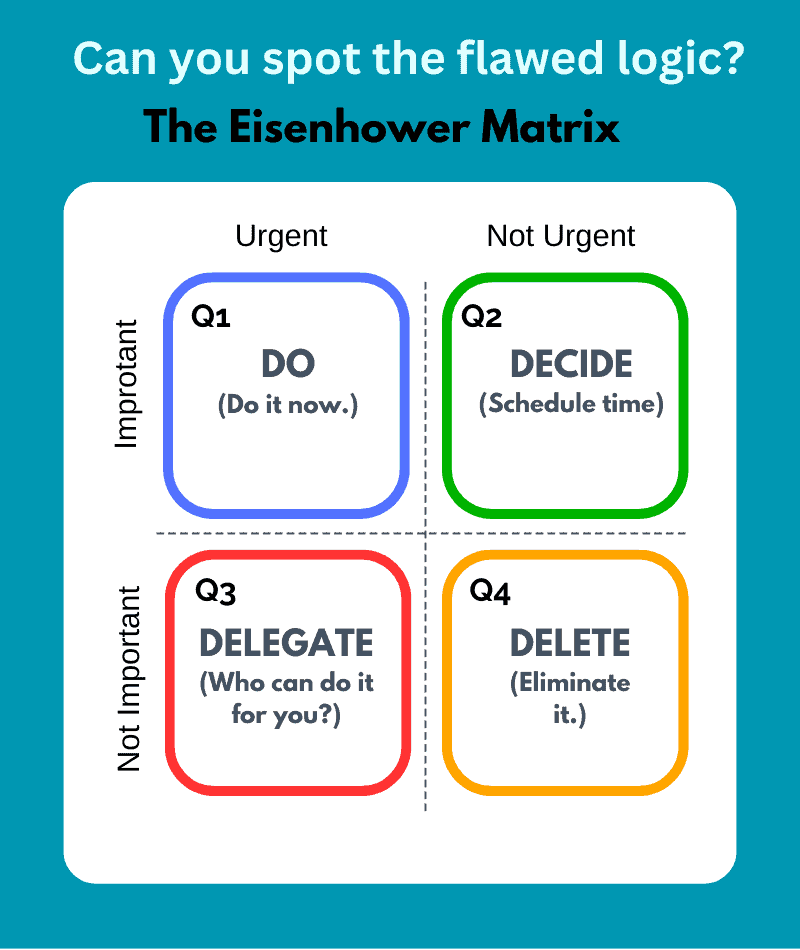In a post last week, I asked people to comment on the flawed logic embedded in what’s come to be called the Eisenhower Matrix.

It should be noted that President Eisenhower probably never used the Eisenhower Matrix, but it has become a favorite for productivity pundits and time management gurus who promote the matrix as a way to help you prioritize your work and your tasks.
The idea is that work is carved up into four quadrants: (Q1) the urgent and important, (Q2) the important and non-urgent, (Q3) the urgent but not important, and (Q4) the not urgent and not important.
Based upon that categorization, the pundits give you a guideline that says you should be eliminating Quadrant 4, delegating Quadrant 3, scheduling time for Quadrant 2, and prioritizing doing the activities in Quadrant 1.
Now, there are some significant flaws in this, which many of you pointed out in your comments.
Flaw #1: The Illogical Delegation of Non-Important Tasks. If something’s not important, why would you delegate it to anybody? If it’s not important, why do it? And why would you waste someone else’s time to do this unimportant task?
Flaw #2: The DIY Fallacy. This assumption plays into your ego, but that’s not a great way to live. Even if something is important, other people can help. For example, if you need heart surgery (important and might even be urgent), you certainly wouldn’t do it yourself. You would find a capable person to help you. And even when you are the expert, that doesn’t mean you are the only one capable of handling the situation.
And there are more flaws if you dig deeper.
To organize your work more effectively, you need a dash of courage, a bit of judgment, and a bucket load of humility.
Shifting From Tasks to Objectives
Traditional time management techniques, such as creating to-do lists or scheduling tasks in calendars, focus heavily on managing tasks rather than the objectives they support.
While these methods may help organize your day, they often leave you stuck in a perpetual cycle of busyness.
You find yourself ticking off tasks without considering whether they contribute meaningfully to your larger goals.
This task-oriented approach overlooks the strategic element of prioritizing based on your objectives, where the impact of a task should be weighed against its contribution to your priority objectives.
Transitioning from a task-centric mindset to one focused on objectives marks a pivotal shift in how you approach your daily life and work. This shift is more than a mere change in perspective; it’s a transformative approach that reorients your actions towards meaningful outcomes.
The central premise here is straightforward yet profound: be driven not by the multitude of tasks demanding your attention but by the overarching objectives they aim to fulfill.
Here’s how you can get started:
- Create a parking lot for the “posteriorities”: To focus on your priorities, you need a place to put what Peter Drucker called your posteriorities (the things you’ve decided not to do.) Create a safe and referenceable place on a page, notebook, Notion board, or anywhere you want to list all the things you’re not going to do now. This will help you close these open loops and focus.
- List all your objectives: Make a master list of all of your objectives to get a clear view of what you aim to achieve.
- Select your posteriorities and put them in your parking lot (courage is needed here). Choose all the things you will postpone and put them in your parking lot. This means everything except the top 3-5 objectives (ideally 3).
- Force rank your top 3-5 priority objectives: Get clear about your priorities and make sure everyone else knows them, too. If people ask you to do something else, one of these has to come off the list and get parked.
- Generate Tasks from Top Objectives: For each of your top objectives, generate a list of tasks necessary for their accomplishment. Within your tasks, focus on completing those related to your highest-ranked objective before moving on to lower-order objectives.
- Adopt a Single-Threaded Work Approach: Focus on completing current tasks for your top-ranked objective before starting new ones. This approach emphasizes finishing over starting, ensuring progress in your top objectives.
- Identify and Undertake Unique Tasks: Determine tasks that you are uniquely qualified to do and focus on those. Delegate the rest to avoid spreading yourself too thin.
- Address and Fix Systemic Crises: If crises hinder your progress, temporarily put one of your top objectives in your parking lot and focus on resolving the underlying system issues causing these crises.
- Learn to Say No to Non-Essential Tasks: Develop the skill of saying no to tasks that do not align with your essential objectives. This helps maintain focus and avoid unnecessary workload.
Effective priority management transcends mere time management; it’s about aligning every effort with something bigger and more meaningful.
As you move forward, focus on being impactful. Aim not to just manage your time but your priorities in a way that brings you closer to your aspirations and true potential.
I hope this gives you some inspiration.
Until next time, be enactive; Be someone who happens to the world.
Best,
Alex
Whenever you’re ready, there are 3 ways I can help you:
1. Win Your Day – Get the system I use every day to help me be more enactive and productive.
2. Strategic Thinking For Advantage – A training program for aspiring leaders ready to turn strategic thinking into a superpower.
3. Coaching and Consulting – Contact me for coaching and consulting services in North America.

 The Essential Skill Every Leader Needs, But Many Lack
The Essential Skill Every Leader Needs, But Many Lack